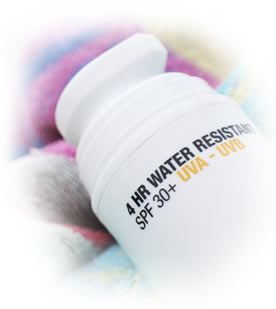

| Visitors Now: | |
| Total Visits: | |
| Total Stories: |

| Story Views | |
| Now: | |
| Last Hour: | |
| Last 24 Hours: | |
| Total: | |
Sunscreens Exposed: Nine Surprising Truths

Sunscreens prevent sunburns, but beyond that simple fact surprisingly little is known about the safety and efficacy of these ubiquitous creams and sprays. EWG’s review of the latest research unearthed troubling facts that might tempt you to give up on sunscreens altogether. That’s not the right answer. Despite the unknowns about sunscreens’ efficacy, public health agencies still recommend using them, just not as your first line of defense against the sun. At EWG we use sunscreens, but we look for shade, wear protective clothing and avoid the noontime sun before we smear on the cream. Here are the surprising facts:
1. There’s no consensus that sunscreens prevent skin cancer.
The FDA’s 2011 sunscreen rules allow sunscreen makers to advertise that using their products can decrease the risk of skin cancer and sun-related skin aging. But a wide range of public health agencies – including the FDA – have found very little evidence that sunscreen prevents most types of skin cancer. In reviewing the evidence, the FDA said that the available clinical studies “do not demonstrate that even [broad spectrum products with SPF greater than 15] alone reduce the risk of skin cancer and early skin aging.” The agency also said that it is “not aware of any studies examining the effect of sunscreen use on the development of melanoma.” The International Agency for Research on Cancer recommends clothing, hats and shade as primary barriers to UV radiation. It says that “sunscreens should not be the first choice for skin cancer prevention and should not be used as the sole agent for protection against the sun” (IARC 2001a). Read more.
2. There’s some evidence that sunscreens might increase the risk of the deadliest form of skin cancer for some people.
Some researchers have detected an increased risk of melanoma among sunscreen users. No one knows the cause, but scientists speculate that sunscreen users stay out in the sun longer and absorb more radiation overall, or that free radicals released as sunscreen chemicals break down in sunlight may play a role. One other hunch: Inferior sunscreens with poor UVA protection that have dominated the market for 30 years may have led to this surprising outcome. All major public health agencies still advise using sunscreens, but they also stress the importance of shade, clothing and timing. Read more.
3. There are dozens of high-SPF products — but no proof they’re better.
The FDA has proposed prohibiting the sale of sunscreens with SPF values higher than “50+.” The agency has written that values higher than 50 would be “misleading to the consumer,” given that there is an “absence of data demonstrating additional clinical benefit” (FDA 2011a), and that “there is no assurance that the specific values themselves are in fact truthful…” (FDA 2007). Scientists are also worried that high-SPF products may tempt people to stay in the sun too long, suppressing sunburns (a late, key warning of overexposure) while upping the risks of other kinds of skin damage.
Flouting the FDA’s proposed regulation, companies continue to sell high-SPF offerings in 2012. More than 1 in 7 products now lists SPF values higher than 50+, compared to only 1 in 8 in 2009, according to EWG’s analysis of more than 800 beach and sport sunscreens. Among the worst offenders are Walgreens and Aveeno brands. These manufacturers boast SPF values greater than 50+ on more than 40 percent of their sunscreens Read more.
4. Too little sun might be harmful, reducing the body’s vitamin D levels.
Sunshine serves a critical function in the body that sunscreen appears to inhibit — producing vitamin D. The main source of vitamin D in the body is sunshine, and the compound is enormously important to health – it strengthens bones and the immune system, reduces the risk of various cancers (including breast, colon, kidney and ovarian cancers) and regulates at least a thousand different genes governing virtually every tissue in the body (Mead 2008). About one-fourth of Americans have borderline low levels of vitamin D, and 8 percent have a serious deficiency (CDC 2012). Particular groups are at the highest risk – breast-fed infants, people with darker skin and people who have limited sun exposure (NIH 2012).
Some people can make enough vitamin D from 10 to 15 minutes of unprotected sun exposure several times a week. But many others cannot. The right amount depends on the individual’s age, skin tone, the intensity of sunlight, time outdoors and skin cancer risk. Check with your doctor to see if you should get a vitamin D test or if you should take seasonal or year-round supplements. Read More


